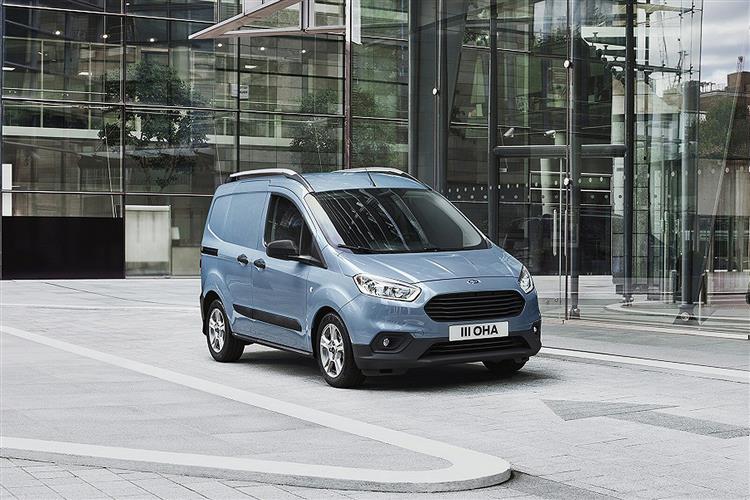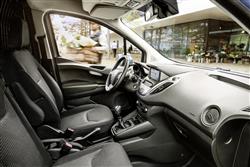This is a sample, showing 30 seconds of each section.
A COURIER THAT DELIVERS (some text hidden) SECTIONED_fordtransitcourier101214
By Jonathan Crouch
Introductionword count: 50
Ford's smallest style of Transit, the Transit Courier launched in 2014, proved in first generation form to be predictably efficient but deceptively spacious and capable. You certainly wouldn't expect it to swallow up to 2.6m3 or lug around as much as 660kgs. As a result, it's a van that can.
Modelsword count: 7
small van (1.5 EcoBlue diesel/1.0 EcoBoost petrol)
Historyword count: 237
Today, a Ford Transit can be many quite separate things. Depending on the model range you prefer, select from either large or very large, compact or, as in this case, spaciously small. We're talking about the first generation Transit Courier, launched in 2014. This Courier model might have sat on much the same underpinnings as a Fiesta van sold in this period but in contrast to its stablemate, it was designed first and foremost as a van, one reason why it was considerably more spacious and usable than that LCV Fiesta. It was aimed at the urban delivery market and businesses whose cargo needs didn't really justify a stretch to Ford's larger Focus hatch-derived Transit Connect model. Prior to 2014 and since 2008, these kinds of customers had been mainly served by the shared design known either as a Citroen Nemo, a Peugeot Bipper or a Fiat Fiorino, vans that had this little segment pretty much to themselves until this Transit Courier arrived early in 2014. Ford reckoned that LCVs of this sort had traditionally under-performed in terms of their usability. In response, this Courier model had the potential for slightly greater carriage capacity and a significantly greater payload than these city van rivals. The Blue Oval brand also believed that it this Transit Courier model brought to this segment traditional Transit toughness. It sold until late 2023, when it was replaced by a new generation design.
What You Getword count: 442
City vans need to do that seemingly impossible thing of being big on the inside but as small as is practicable outside. That's perhaps one reason why many of them look very similar - a cube and a bonnet with the brand family face grafted on the front. The Transit Courier doesn't deviate too far from this template, although the steeply raked windscreen does give it more of a one-box look. Couple that with the prominent Ford front grille and the subtly flared wheel arches and you could even say that this LCV looks quite handsome. It'll be practical too thanks to rugged bumpers and body side mouldings that provide added protection and minimise repair costs. Step inside and you'll be reminded that Ford also knows a thing or two about cabin design. It's more spacious than you would expect a van in this segment to be and also unusual in this class is the provision of a steering wheel that adjusts for both reach and rake. Build quality from the Turkish factory seems strong and this is a well thought-out mobile office environment too, with smart stowage including a "mega-centre" console capable of storing A4 documents and small laptops. There's also the option of overhead stowage and a storage drawer under the driver's seat. A so-called 'Device Dock' in the centre of the instrument panel is a unique feature in this class and enables occupants to store, mount and charge mobile devices, including phones and satnavs. In the load area, a 2.3m3 load volume is revealed and, thanks to a load space width between the wheel arches of 1,012mm, there's enough room for a standard euro pallet, with the total load space width measuring 1,488mm and the area here lit by ultra-bright LED load space lighting (where that's option was taken up). That load volume isn't quite enough for this Courier to match the 2.5m3 offered by the rival Peugeot Bipper/Citroen Nemo/Fiat Fiorino design of this period, so if you want to exceed that, you'll need to get a model whose original owner paid extra for the fold-dive passenger seat which works with a folding mesh bulkhead and increases load capacity to 2.6m3. This feature increases load area length from 1.62m to a 2.59m total of the kind you'd expect from a much larger van. Even at 1.62m though, you're talking longest-in-class load length, with 100mm more load length than you'd get in that rival Nemo/Bipper/Fiorino design. The GVM (or 'Gross Vehicle Mass') of this Courier is either 1,795kgs for the diesels or 1,775kgs for the petrol model. And talking of weight, the generous maximum payload capacity of up to 660kg.
To see the full road test text contact us on 0330 0020 227
Pictures (high res disabled)

.jpg)
|

|
Scoring (subset of scores)
Category:
| Performance | |
| Handling | |
| Comfort | |
| Space | |
| Styling, Build, Value, Equipment, Depreciation, Handling, Insurance and Total scores are available with our full data feed. | |





